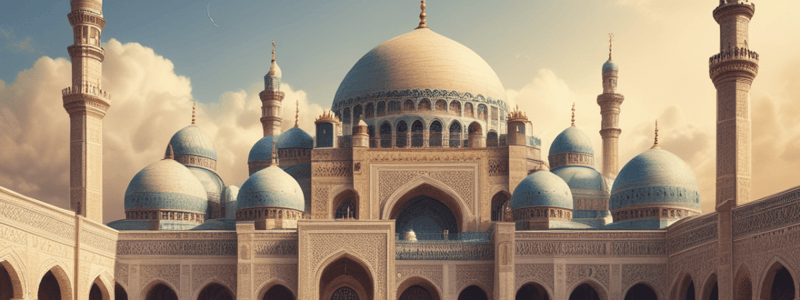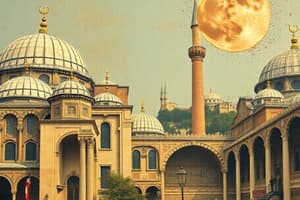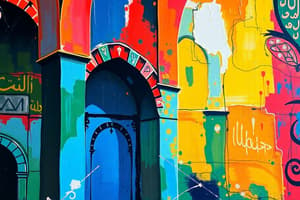Podcast
Questions and Answers
What is the Taj Mahal primarily constructed with?
What is the Taj Mahal primarily constructed with?
- Red sandstone
- White marble (correct)
- Basalt
- Granite
Which Islamic monument is believed to be the place from which the Prophet Muhammad ascended into heaven?
Which Islamic monument is believed to be the place from which the Prophet Muhammad ascended into heaven?
- Dome of the Rock (correct)
- The Great Mosque of Cordoba
- Alhambra
- Ka'aba
Which description best fits the Great Mosque, Iraq?
Which description best fits the Great Mosque, Iraq?
- It has a richly decorated and elaborate palace and fortress.
- It has a prayer hall comprised of double arcades.
- It has a raised platform surrounded by four minarets.
- It has a cone-shaped minaret encircled by an outer ramp in the form of a spiral. (correct)
Which structure is known for its horseshoe-formed lower arches with white stone and red brick voussoirs?
Which structure is known for its horseshoe-formed lower arches with white stone and red brick voussoirs?
Who built the Taj Mahal?
Who built the Taj Mahal?
Where is the Ka'aba located?
Where is the Ka'aba located?
Which city is considered the center of the Islamic world?
Which city is considered the center of the Islamic world?
Where did early Chinese settlements form?
Where did early Chinese settlements form?
Which philosophical belief emphasizes individualism and transcendence through direct connection with the natural world?
Which philosophical belief emphasizes individualism and transcendence through direct connection with the natural world?
What are the decoration characteristics of Taoist architecture?
What are the decoration characteristics of Taoist architecture?
Which of the following elements is NOT associated with Confucianism in architecture?
Which of the following elements is NOT associated with Confucianism in architecture?
What is typically represented by the dragon in Confucian architecture?
What is typically represented by the dragon in Confucian architecture?
What architectural element can be found only in the most magnificent buildings such as palace and temple halls?
What architectural element can be found only in the most magnificent buildings such as palace and temple halls?
How were the yellow tiles used in ancient Chinese architecture?
How were the yellow tiles used in ancient Chinese architecture?
Which of the following is NOT a decorative symbol in Confucian architecture?
Which of the following is NOT a decorative symbol in Confucian architecture?
What shape is the central deepest part of the Zaojing or caisson ceiling?
What shape is the central deepest part of the Zaojing or caisson ceiling?
What is the primary purpose of a pagoda?
What is the primary purpose of a pagoda?
Which part of a pagoda often enshrines a statue of Buddha?
Which part of a pagoda often enshrines a statue of Buddha?
What architectural structure is a Pai-lou?
What architectural structure is a Pai-lou?
Which material is typically used to construct a Pai-lou?
Which material is typically used to construct a Pai-lou?
What is a pavilion primarily used for?
What is a pavilion primarily used for?
Which part of the pagoda resembles the original image of the stupa from India?
Which part of the pagoda resembles the original image of the stupa from India?
Which social class was considered the highest in the River in the south society?
Which social class was considered the highest in the River in the south society?
During which period did the Shang Dynasty exist?
During which period did the Shang Dynasty exist?
What was Qin Shi Huangdi known for in the Qin Dynasty?
What was Qin Shi Huangdi known for in the Qin Dynasty?
Which material is jade a symbol of in Chinese culture?
Which material is jade a symbol of in Chinese culture?
Which of the following describes Blue and white wares in porcelain?
Which of the following describes Blue and white wares in porcelain?
What is notable about the Tang Dynasty?
What is notable about the Tang Dynasty?
Which dynasty is associated with the spread of Buddhism in China?
Which dynasty is associated with the spread of Buddhism in China?
What are the main components of traditional Chinese architecture?
What are the main components of traditional Chinese architecture?
Which Chinese architectural landmark served as a home for 24 emperors for nearly 500 years?
Which Chinese architectural landmark served as a home for 24 emperors for nearly 500 years?
Which landmark was built as a residence for the Dalai Lama and rises 200 meters against a hillside?
Which landmark was built as a residence for the Dalai Lama and rises 200 meters against a hillside?
In which year was Japan closed to outside world due to isolation from foreign influence?
In which year was Japan closed to outside world due to isolation from foreign influence?
What is the primary religion practiced in Japan?
What is the primary religion practiced in Japan?
Which Japanese island is the principal one?
Which Japanese island is the principal one?
What material primarily constitutes the hilly and forested geography of Japan?
What material primarily constitutes the hilly and forested geography of Japan?
Which type of Japanese painting is based on geometric forms rather than the fluid forms of China?
Which type of Japanese painting is based on geometric forms rather than the fluid forms of China?
Which Chinese architectural landmark served as a means of communication?
Which Chinese architectural landmark served as a means of communication?
Which type of decoration involves the use of glass pieces assembled into a pattern?
Which type of decoration involves the use of glass pieces assembled into a pattern?
What is the term for the tower from which the call to prayer is made in a mosque?
What is the term for the tower from which the call to prayer is made in a mosque?
What feature of a mosque indicates the direction towards Mecca?
What feature of a mosque indicates the direction towards Mecca?
Which part of a mosque houses the praying niche?
Which part of a mosque houses the praying niche?
What is the term for the raised platform used for ceremonial announcements in a mosque?
What is the term for the raised platform used for ceremonial announcements in a mosque?
What fundamental feature of a mosque is often cloistered or arcaded?
What fundamental feature of a mosque is often cloistered or arcaded?
What is the main purpose of a Madrasah in Islamic architecture?
What is the main purpose of a Madrasah in Islamic architecture?
Which architectural landmark is located in Jerusalem?
Which architectural landmark is located in Jerusalem?
What is Makimono painting executed on?
What is Makimono painting executed on?
Which medium features heavily in the Ukiyo-e genre?
Which medium features heavily in the Ukiyo-e genre?
What demand did the new craze for tea ceremony create?
What demand did the new craze for tea ceremony create?
Which pattern is characterized by strong floral and brocade designs in heavily saturated colors?
Which pattern is characterized by strong floral and brocade designs in heavily saturated colors?
What tool is used in the tea ceremony to whisk the tea?
What tool is used in the tea ceremony to whisk the tea?
Which of the following is characterized by a decorative curved, single-edged blade with a circular or squared guard?
Which of the following is characterized by a decorative curved, single-edged blade with a circular or squared guard?
What is the art form involving cultivating miniature trees called?
What is the art form involving cultivating miniature trees called?
What is the Japanese art of folding paper?
What is the Japanese art of folding paper?
Which of the following features is NOT characteristic of Japanese architecture?
Which of the following features is NOT characteristic of Japanese architecture?
What is the purpose of a Torii Gateway in a Shinto shrine?
What is the purpose of a Torii Gateway in a Shinto shrine?
Which of the following structures is found in front of the honden in a Shinto shrine?
Which of the following structures is found in front of the honden in a Shinto shrine?
In Japanese Buddhist temples, where are sacred texts read?
In Japanese Buddhist temples, where are sacred texts read?
What is the primary feature of the Ise Shrine?
What is the primary feature of the Ise Shrine?
What is the main purpose of a Shinto temple?
What is the main purpose of a Shinto temple?
Which of the following is NOT a part of Japanese Buddhist architecture?
Which of the following is NOT a part of Japanese Buddhist architecture?
What does Shintoism aim to achieve with purification, prayers, and offerings?
What does Shintoism aim to achieve with purification, prayers, and offerings?
Which architectural feature is found in a Japanese Buddhist temple?
Which architectural feature is found in a Japanese Buddhist temple?
What is the traditional Japanese tea house called?
What is the traditional Japanese tea house called?
Which landmark enshrines the sun goddess Amaterasu Omikami?
Which landmark enshrines the sun goddess Amaterasu Omikami?
Which structure is known for having 6 storeys and curving eaves?
Which structure is known for having 6 storeys and curving eaves?
Which period saw the advent of the first public baths in Japan?
Which period saw the advent of the first public baths in Japan?
What is the Ilocano native term for large earthenware vessels?
What is the Ilocano native term for large earthenware vessels?
What was the Manunggul jar used for?
What was the Manunggul jar used for?
What is the Vigan tile associated with?
What is the Vigan tile associated with?
What is T'nalak cloth woven from?
What is T'nalak cloth woven from?
Which weaving technique is characterized by a resist dyeing process used on either the warp or weft before weaving?
Which weaving technique is characterized by a resist dyeing process used on either the warp or weft before weaving?
What does the design of Binacol weaving represent?
What does the design of Binacol weaving represent?
What is a prominent characteristic of Ifugao Ikat weaving?
What is a prominent characteristic of Ifugao Ikat weaving?
In which region is PIS SIYABIT typically used, and by whom?
In which region is PIS SIYABIT typically used, and by whom?
What is Inaul fabric associated with?
What is Inaul fabric associated with?
What distinguishes Inabel/Abel Iloco weaving technique?
What distinguishes Inabel/Abel Iloco weaving technique?
What weaving tradition is known for its psychedelic optical art designs?
What weaving tradition is known for its psychedelic optical art designs?
Flashcards are hidden until you start studying
Study Notes
History of Art and Architecture
Vaulting
- Decorations in vaulting: moldings, friezes, carvings, stone inlay, mosaic, patterned brickwork, carved stucco, ceramic facing, glass mosaic, painting, timber inlay, Arabesques, and decorative bonding for brickwork.
Types of Architecture
- Mosque/Masjid: a place for worship, with a inward-looking building, no positive object of attention, and a cloistered or arcaded courtyard.
- House with courtyard: a residential building with a central courtyard.
- Fortress: a fortified building for defense.
- Madrasah: a theological school, arranged around a courtyard.
Parts of a Mosque
- Sahn: courtyard of a mosque.
- Haram: covered area in front of the qibla wall.
- Mihrab: niche oriented towards Mecca, indicating the direction of prayer.
- Dikka: a tribune raised upon columns from which the Koran is recited.
- Maqsura: an enclosure in a mosque, made of an openwork screen.
- Minbar: a raised platform for ceremonial announcements.
- Iwan: an open-fronted vault facing a court.
- Minaret: a tower from which a call to prayer is made.
- Qibla wall: axis oriented towards Mecca.
- Bab: a gateway.
- Musalla: the central area for prayer.
Architectural Landmarks
- Taj Mahal, India: a white marble tomb with a multi-patterned ceramic exterior.
- Dome of the Rock, Jerusalem: a historic Islamic monument.
- Great Mosque of Cordoba, Spain: a mosque with a prayer hall featuring double arcades.
- Great Mosque, Iraq: a mosque with a cone-shaped minaret.
- Alhambra, Spain: a palace and fortress.
Chinese Art
Historical Background
- Early settlements in the Yellow River, Wei River, and Yangzi River.
- Four main social classes: scholar-gentry, peasants, artisans, and merchants.
Periods
- Neolithic (6000-1700 BC)
- Eritou period (2000-1600 BC)
- Shang Dynasty (1650-1050 BC)
- Zhou Dynasty (1050-221 BC)
- Qin Dynasty (221 BC-AD 207)
- Han Dynasty (206 BC-AD 220)
- Kingdoms (265-420)
- Northern dynasties (386-581)
- Southern Dynasties (420-589)
- Sui Dynasty (581-618)
- Tang Dynasty (618-908)
Shang Dynasty
- Known for bronze casting.
- Royal family lived in a walled palace.
Qin Dynasty
- Unified China by implementing strict laws, taxing everyone, and introducing a standard script.
- Ordered the burning of scholarly books.
Han Dynasty
- Founded by Lui Bang.
- Controlled the Silk Road, and Buddhism started to spread.
- Extended ancient Chinese boundaries.
Tang Dynasty
- Golden Age of Chinese Arts.
Architecture
Types of Chinese Art
- Porcelain: a ceramic material made by heating raw materials.
- Blue and white wares: glazed using a transparent porcelain glaze.
- Blanc de Chine: a type of white porcelain.
- Polychrome Colored porcelain: a type of porcelain with multiple colors.
- Jade ware: a symbol of vitality and authority.
- Calligraphy: Chinese writing done on silk and paper.
- Paintings: made on paper and silk, usually in long scroll forms.
Principles in Chinese Architecture
- Taoism: emphasizes individualism and transcendence.
- Confucianism: emphasizes strict adherence to social conventions and rituals.
- Buddhism: a path of practice and spiritual development.
Taoism in Art and Architecture
- Decoration reflects Taoist pursuit of luck and fulfillment.
- Use of natural topography to build towers, pavilions, and gardens.
Confucianism in Art and Architecture
- Yin-Yang: balance and symmetry.
- Feng shui: traditional concepts of five elements.
- Number nine: especially applied in imperial architecture.
- Concentric or symmetrical shapes.
- Significance of colors: yellow, green, red, and phoenix.
Architectural Elements
- Dougong bracket: a structural member found between the top of a column and across beam.
- Curved roof: a characteristic of Chinese architecture.
- Glazed tiles: used exclusively on palace buildings and big mansions.
- Zaojing or caisson ceiling: a decorative ceiling.
Presence of garden or landscaping
- Use of natural topography to build towers, pavilions, and gardens.
Japanese Art
Historical Background
- Chinese influence.
- Feudalism with castes of emperor, nobles, shoguns, and military.
- Isolation from foreign influence for 200 years.
- Religions: Shinto, Buddhism.
- Geography: Principal island, Honshu; smaller islands at north and south.
- Prevalence of earthquakes.
- Hilly and forested country.
- Un-stratified volcanic stone.
Types of Japanese Art
- Paintings: drew direct inspiration from China.
- Yamato: a national style of painting based on geometric forms.
- Kakemono: a painting executed on a vertical silk roll.
- Makimono: a painting executed on a horizontal silk roll.
- Wood-block prints (Ukiyo-e): a genre of Japanese woodblock prints.
- Ceramics: created a demand for pottery vessels.
Japanese Architecture
- Made of wood.
- Indigenous religious sensibility.
- Adaptable to climate and topography.
- Flexible.
- Open space.
Shintoism
- Shinto: "the way of the gods".
- Kami: Shinto gods.
- No founder.
- Purification, prayers, and offerings to the kami.
Architectural Forms
- Shinto Temples (Jinja): the main purpose is for the enshrinement and worship of a kami.
- Torii Gateways: open gateways, consisting of two pillars and an architrave.
- Honden: building that contains the body of the goshintai.
- Haiden: hall of worship of the Shinto shrine.
Buddhist Temples
- Complex group of monastic buildings.
- Pagodas: reliquary.
- Kodo: lecture hall.
- Kondo: image hall.
Filipino Art
Pre-colonial Period Art
- Pottery: found in the Tabon Caves of Palawan.
- Weaving: T'nalak, Ikat, Binacol, Inabel/Abel Iloco, and Inaul.
Architectural Landmarks
- Ise Shrine: the oldest Shinto temple in Japan.
- Himeji Castle: the most impressive of the fortified residences.
Studying That Suits You
Use AI to generate personalized quizzes and flashcards to suit your learning preferences.




